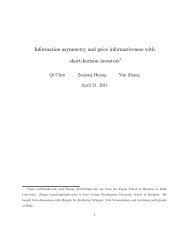Does Enforcement of Intellectual Property Rights Matter in China ...
Does Enforcement of Intellectual Property Rights Matter in China ...
Does Enforcement of Intellectual Property Rights Matter in China ...
You also want an ePaper? Increase the reach of your titles
YUMPU automatically turns print PDFs into web optimized ePapers that Google loves.
the exclusion restriction criterion.<br />
In Table 3, we exam<strong>in</strong>e the impact <strong>of</strong> IP rights enforcement on new external equity. In the<br />
probit regressions, IPP2 has a negative and significant impact on the new external equity as<br />
predicted, while the coefficient <strong>of</strong> IPP1 is <strong>in</strong>significant or weak. In the IV regressions, however,<br />
neither measure <strong>of</strong> IP rights enforcement is significant. Therefore, the support for Corollary 1 is<br />
weak, at best.<br />
Insert Table 3<br />
4.1.2 Informal f<strong>in</strong>anc<strong>in</strong>g ratio<br />
We now <strong>in</strong>vestigate the determ<strong>in</strong>ants <strong>of</strong> <strong>in</strong>formal f<strong>in</strong>anc<strong>in</strong>g. To facilitate comparison, we use<br />
the same specification as <strong>in</strong> Equation (1) to estimate the effects <strong>of</strong> IP rights enforcement on the ratio<br />
<strong>of</strong> <strong>in</strong>formal f<strong>in</strong>anc<strong>in</strong>g. The difference is that we now use l<strong>in</strong>ear regressions, s<strong>in</strong>ce the dependent<br />
variable is a cont<strong>in</strong>uous variable. The standard errors are robust to correction for heteroskedasticity<br />
and with<strong>in</strong>-prov<strong>in</strong>ce correlations.<br />
Insert Table 4<br />
Column 1 <strong>of</strong> Table 4 shows that IPP1 <strong>in</strong>creases <strong>in</strong>formal f<strong>in</strong>anc<strong>in</strong>g ratio, as predicted <strong>in</strong><br />
Hypothesis 2. A one-standard-deviation <strong>in</strong>crease <strong>in</strong> IPP1 raises the <strong>in</strong>formal f<strong>in</strong>anc<strong>in</strong>g ratio by 2.6<br />
percentage po<strong>in</strong>ts. Mov<strong>in</strong>g from lowest-IPP1 prov<strong>in</strong>ce to the highest-IPP1 prov<strong>in</strong>ce <strong>in</strong>creases the<br />
<strong>in</strong>formal f<strong>in</strong>anc<strong>in</strong>g ratio by 13.8 percentage po<strong>in</strong>ts, about half <strong>of</strong> the sample mean.<br />
After controll<strong>in</strong>g for the prov<strong>in</strong>cial-level characteristics, IPP1 still has a positive and<br />
statistically significant effect on the proportion <strong>of</strong> <strong>in</strong>formal f<strong>in</strong>anc<strong>in</strong>g <strong>in</strong> new debt (Column 2). The<br />
development <strong>of</strong> bank<strong>in</strong>g system has a negative and significant effect on the <strong>in</strong>formal f<strong>in</strong>anc<strong>in</strong>g ratio,<br />
i.e., better bank<strong>in</strong>g development enables firms to rely less on the more expensive external f<strong>in</strong>ance.<br />
25



